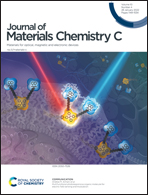Air-processed stable near-infrared Si-based perovskite light-emitting devices with efficiency exceeding 7.5%†
Abstract
Organic perovskite materials have attracted considerable attention because of their potential applications in various types of opto-electronic devices. Nowadays, obtaining high-performance devices fabricated in ambient atmosphere is a challenge. In this study, we report Si-based near-infrared (NIR) perovskite light-emitting devices (PeLEDs) with enhanced efficiency by an air-processed technique with two composite layers. One layer is constructed using 4,4′-bis(N-carbazolyl)-1,1′-biphenyl (CBP) with poly-TPD coating as a hole transport layer (HTL) to balance carrier injection, and the other is constructed doping poly(methyl methacrylate) (PMMA) with antisolvent to passivate defects and protect MAPbI3 from degradation by water and oxygen. Through these two composite layers, the EL performance is enhanced with an external quantum efficiency (EQE) of 7.5%, and the stability is also improved to 200 min after the introduction of another m-PMMA layer. Our results provide a simple way to manufacture high-efficiency and stable PeLEDs under air condition.



 Please wait while we load your content...
Please wait while we load your content...